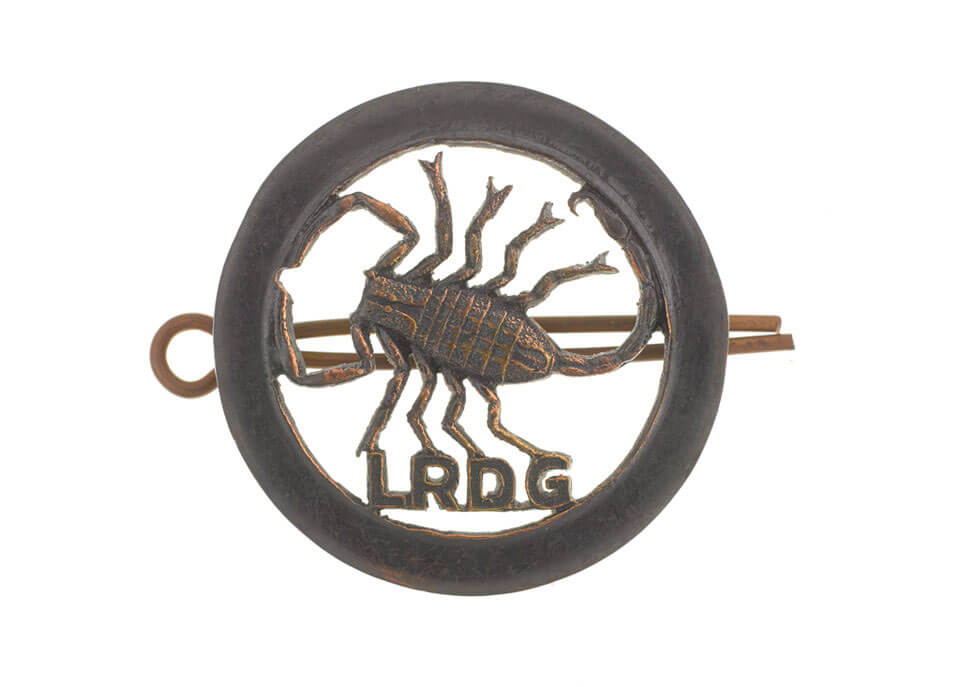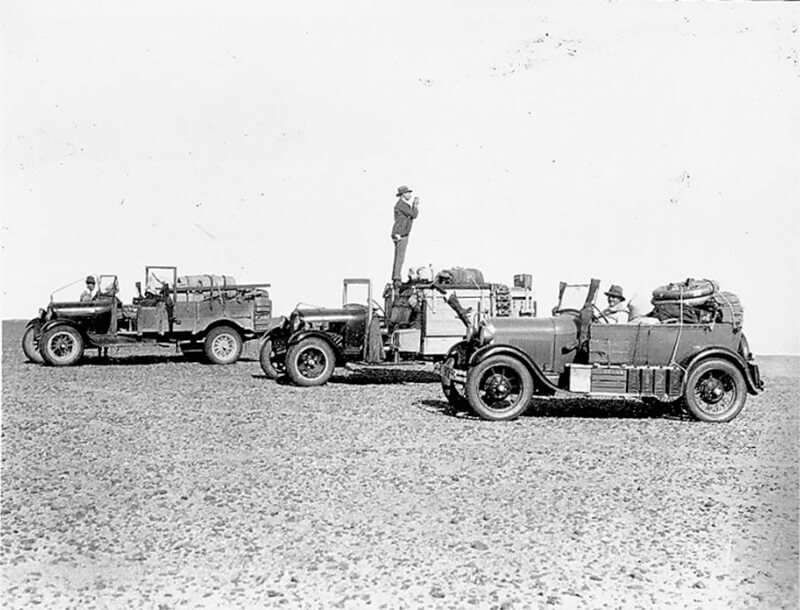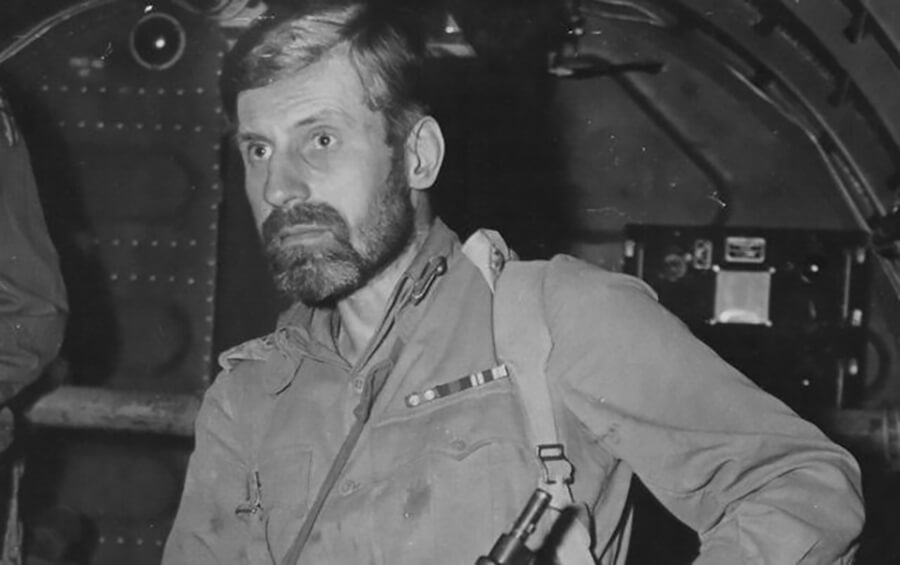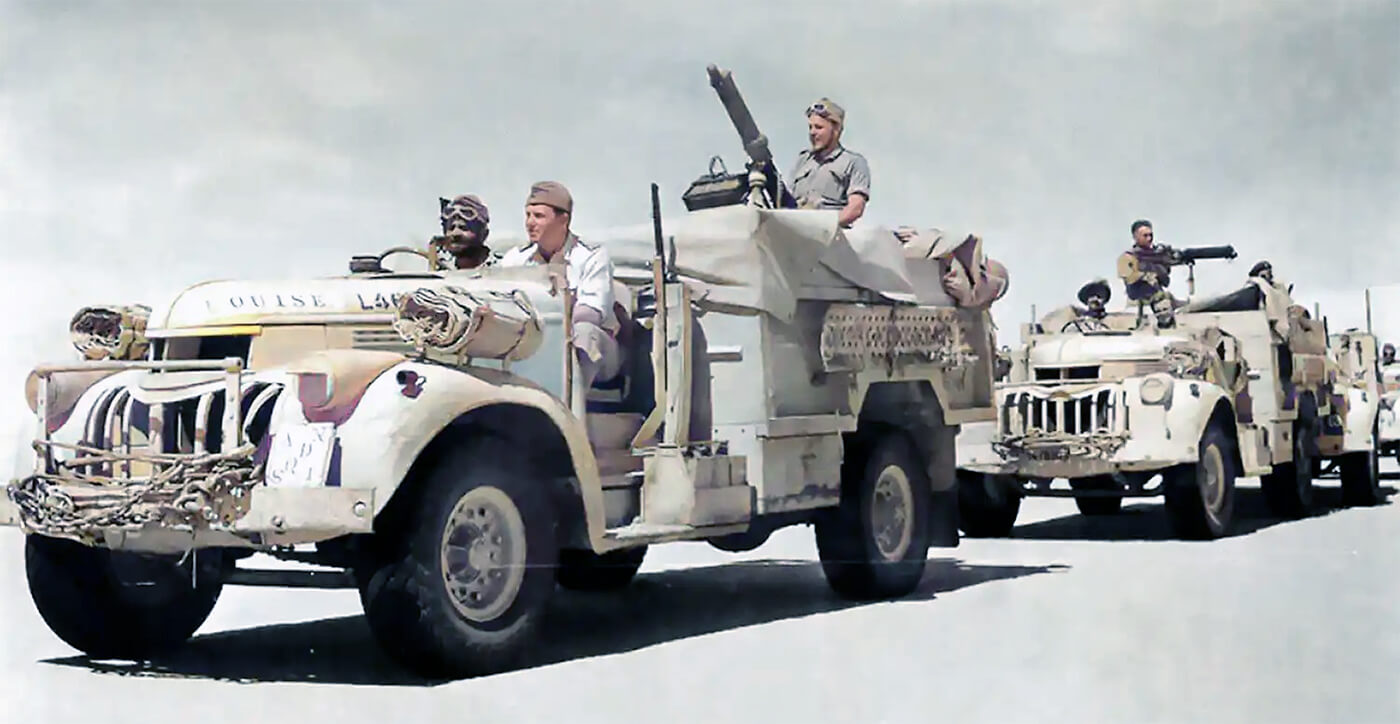| Page Created |
| April 24th, 2022 |
| Last Updated |
| March 4th, 2024 |
| Great Britain |
 |
| Additional Information |
| Unit Order of Battle Commanders Operations Equipment Multimedia Mulimedia 2 Multimedia 3 Sources Biographies |
| Badge |
 |
| Motto |
| Non Vi Sed Arte Not by Strength by Guile |
| Founded |
| July 3rd, 1940 |
| Disbanded |
| August 1st, 1945 |
| Theater of operations |
| North African Desert *Egypt *Libya *Sudan Greece * Dodecanese Islands Albania Yugoslavia Italy |
| Organisational History |
The Long Range Desert Group is the brainchild of Ralph Bagnold. Bagnold had worked in the North African Desert as geologist and desert explorer in the 1930’s. His research group was one of the first to use motorised vehicles for desert exploration. While being in the desert they experimented with new ways to navigate and drive in the unforgiving North African Desert.
Bagnold’s Expedition in 1929
When the war in the North African Desert broke out Bagnold was in Cairo, Egypt. Realising his unique skills could make a difference in the North African Theater he requested a meeting with General Archibald Wavell, the Commander-in-Chief of the Middle East. His request was granted, and they met on June 23rd, 1940. During the meeting Bagnold explained his concept of long range reconnaissance patrols that would drive deep into the North African desert to gather information and observe the Italian army. The information they gather would be radioed to the British Headquarters. Besides the intelligence task Bagnold also suggested the unit could commit “acts of piracy”.
Wavell understood Bagnold’s concept and gave him permission to raise a unit like he described. When Italy declared war on June 10th, 1940, Wavell urgently needed more intelligence on the enemy’s plans, potential paths of attack, and available forces. Aerial reconnaissance was not enough, and Bletchley Park’s codebreaking efforts had not yet provided much useful information. Traditional ground reconnaissance could only gather information on units in the front area. The new Long Range Patrol Unit was intended to fill in the gaps in intelligence.
On July 3rd, 1940, the Long Range Patrol (LRP) is founded. Bagnold is more or less free to recruit whoever he wants. In July 1940, the Provisional War Establishment includes provisions for eleven officers and seventy-six other ranks with forty-three vehicles. His idea is to use men from the Australia or New Zealand. He believes their outdoor kind of living would give them a natural advantage in the North African Desert. Australia refuses but New Zealand is happy to oblige Bagnold’s request. He is allowed to select his men from the 2nd New Zealand Division. Since half of the division volunteers, he has no problems in selecting his troops. In the end he selects two officers and sixty-seven non-commissioned officers and soldiers. Besides these men eighteen administrative and technical personnel are selected for the unit.
After selection, the unit undergoes a strenuous six-week training after which they are inspected by General Wavell and declared ready for action, as the No.1 Long Range Patrol Unit. Their first training patrol followed in August of 1940.
The first training patrol is led by Bagnold, who embarks with two Ford WB trucks, five New Zealanders, and an Arab guide. Their objective is to monitor supply traffic along the track between Jalo and Kufra. Concurrently, Shaw utilises other patrols to establish supply depots along the Libyan border. These depots are crucial for sustaining operations due to the vast distances that would need to be covered later on.
On September 13th, 1940, the unit establishes its inaugural base in the Siwa Oasis. They reach this destination by traversing approximately 240 kilometres across the Egyptian sand desert.
On October 1st, 1940, the unit moves the Isolation Hospital in Abbassia, near Cairo in Egypt as its new headquarters. On October 10th, 1940, the 2nd New Zealand Expeditionary force request fot the return of their personnel. The men are allowed to stay for the time being.
On November 11th, 1940, permission is granted to double the size of the unit, and the revised establishment allowed for twenty-one officers and 271 other ranks, consisting of a headquarters and two squadrons each with three fighting patrols equipped with a total of ninety vehicles. Meanwhile on December 4th, 1940, the unit moves to Camp Maadi near Cairo.
On December 5th, 1940, with the first Guardsmen of Guards (G) Patrol start arriving. G Patrol is formed from the Coldstream Guards and 2nd Battalion Scots Guards under the leadership of Captain Pat Clayton and Major Crichton-Stuart. Comprised of 31 Non-Commissioned Officers and Guardsmen, the unit initially recruits eighteen volunteers from each regiment. Remarkably, these volunteers sign up without knowing much about the unit beyond its reputation as a fighting force.
On October 17th, 1940, Major Orde Wingate arrives in the Middle East with a plan for a large force, approaching the size of a division. The mission of this force would be to disrupt enemy operations in the rear area through actions from bases in the Tibesti area. This force would rely on air resupply to remain mobile and independent of conventional logistics, with the ultimate goal of defeating major enemy units. Despite its ambitious nature, Wingate’s plan is seriously considered in Great Britain and receives a hearing at GHQ Middle East, with the condition that “their desert man,” Bagnold, evaluates the plan.

Major Orde Wingate
Bagnold realises that Wingate’s idea was good in theory but lacked the understanding of terrain, vehicle payloads, fuel consumption, and the air and ground transport available to the resource-strapped Middle East command. He writes a memo for a modified Wingate plan based in part on Stage III of his own original concept. Stage I is reconnaissance and harassment. Stage II involves expanding operations to include cooperation with the Free French in order to gain their recognition as a viable ally and demonstrate to the Arab people that the Italians were not in control of their annexed territory. Stage III calls for the expansion of the Long Range Patrol Unit into a desert mechanised force with its own integral artillery, light armor, and infantry based on portees and 10-ton trucks, as well as an air component for close air support and reconnaissance. These units would operate independently and only combine for specific operations before dispersing again. The plan, is presented with clear data and conclusions, is well-argued but many of its demands, particularly in terms of exclusive air support and manpower, are more than General Headquarters is willing to provide. As a result, Wingate is sent to lead “Gideon Force” in Eritrea.
On December 26th, 1940, Boxing Day, G and T Patrols embark on the Murzuk Raid, joined by French allies, totaling 76 men and 23 vehicles. Their destination Murzuk, is an Italian fort located 1609 kilometers from Cairo, necessitating a grueling 2414-kilometer journey lasting 18 days.
On January 3rd, 1941, the Rhodesian (S) Patrol is raised and the Yeomanry (Y) Patrol on March 9th, 1941. The sixth patrol is never formed, and the authorisation is used instead to create the Royal Artillery Section. This takes place on March 21st, 1941, with the activation of the Royal Artillery H Section. Y Patrol was primarily composed of members from the regiments of the 1st Yeomanry Division. The original Y Patrol comprises mainly men from Yeomanry Regiments, with only a few exceptions. These exceptions include Second Lieutenant Easonsmith from the Royal Tank Regiment, the patrol sergeant from the Royal Scots Greys, and ancillary support personnel such as the fitter, W/T (wireless telegraphy operator), and the medical officer. However, the composition of Y Patrol undergoes a significant change starting from September 1941. From that time on, several members from the 11 Middle East Commando Scottish Commando join their ranks. This reinforces Y Patrol, diversifying its composition.
Bagnold implements a modified Bagnold plan acquiring 10-ton trucks for desert trials and forming a small artillery and tank contingent within the Long Range Desert Group in August 1941. Bagnold is promoted to “Inspector of Desert Troops” in August 1941 to plan the creation of additional desert Long Range Reconnaissance Patrol units, with Group command passing to his second-in-command, Guy Prendergast of the Royal Tank Regiment. The Indian Long Range Squadron is the only unit that resulted from this move before interest in special desert units decreased and Bagnold returns to his old job in signals, effectively losing any further control over deep desert operations.
In August 1941, the Squadrons are restructured. G and Y Patrols now form B Squadron, the remainder of the patrols form A Squadron.
During the end of October and the beginning of November 1941 the Patrols are reorganised into half patrols. This effectively means that every patrol is now spilt in 1 and 2.
By March 1942, the Group reaches its full strength of twenty-five officers and 324 other ranks, including 36 Signals personnel and 36 Light Repair personnel, as well as 130 vehicles. The Indian Long Range Squadron (ILRS) consisted of 7 British officers, 9 British other ranks, 3 Indian officers, and 82 Indian other ranks, organised into a headquarters and two patrols each comprising two half-patrols with thirty-five vehicles like those of the Long Range Desert Group, although the armament is different. From May 11th, 1942 until the end of July 1942 the two patrols from the Indian Long Range Squadron (IRLS) are attached to the Long Range Desert Group.
From June 1941 to August/September 1941, G, H, and Y Patrols are the first three, with H Patrol being a half patrol of eighteen men, consisting of nine men from Y Patrol and nine men from G Patrol. The second set of three patrols, S, T, and R were complete patrols. It’s important to note that H Patrol did not stand for Heavy Section during this period.
By November 1941, the patrols are split into half patrols. G1 is led by Captain Hay, G2 by Lieutenant Timpson, R1 by Captain Jake Easonsmith, R2 by Second Lieutenant Browne, S1 by Captain Holliman, S2 by Second Lieutenant Olivey, T1 by Major Ballantyne, T2 by Captain Hunter, Y1 by Captain Simms, and Y2 by Captain Lloyd Owen.
Between
October 1st, 1942, and April 3rd, 1943, the ILRS in its entirety is attached to the Long Range Desert Group and falls under the command of the Group’s Headquarters.
In May 1943, the Guards G1 and G 2 Patrols are disbanded and their men, along with those from the Heavy Section, are being used to form M 1 and M 2 Patrols of B Squadron alongside Y and S Patrols. With the North African Campaign ending training in Lebanon begins for the Mediterranean theatre. On September 12th, 1943, the Long Range Desert Group deploys to the Aegean alongside the Special Boat Squadron, The Sacred Greek, and Kalpaks as part of Force 292.
On December 29th, 1943, A (New Zealand) Squadron is withdrawn from the Long Range Desert Group and replaced by A (Rhodesian) Squadron.
On March 22nd, 1943, the Long Range Desert Group, minus an advanced party and those parachute training at Rarnal David, embarks for Italy for operations on the Italian mainland and in the Adriatic. lts Headquarters is based at Casa Rosa near Rodi on the Cargano Península.
On June 21st, 1945, the members of the Long Range Desert Group are informed that the unit will be disbanded. On August 1st, 1945, the last men leave the unit finalising the disbandment of the Long Range Desert unit.

